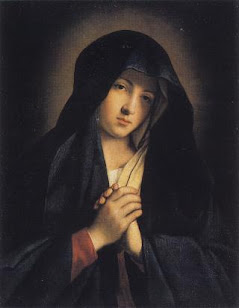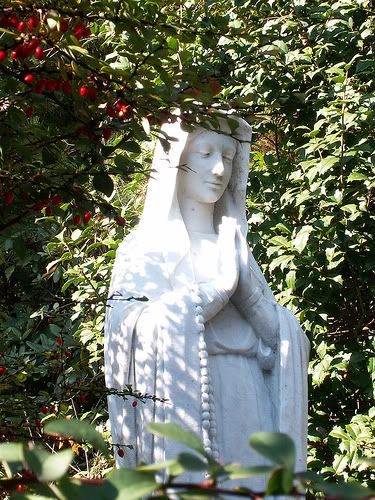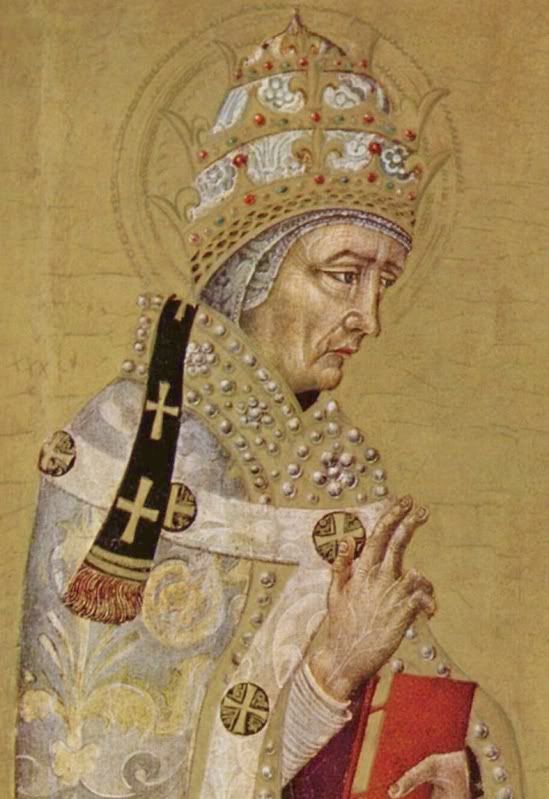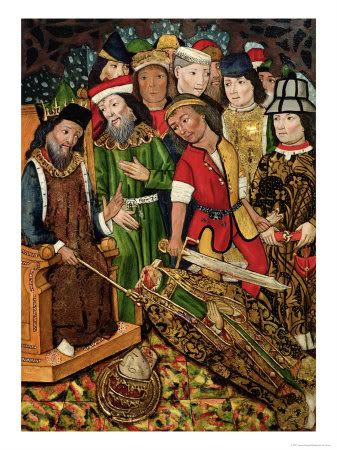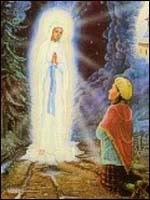Today, January 20, marks the anniversary of the fourth apparition of Our Blessed Mother at Banneux, Belgium, to eleven year old Mariette Beco in 1933. The first three apparitions occurred on January 15, January 18, and January 19. During these encounters, Mariette saw a woman “made of light” smiling at her through her kitchen window, eventually following the Blessed Virgin, praying with her, and obeying her instructions to claim a small stream of water for her. The Blessed Mother said to Mariette, “I am the Virgin of the Poor” and “This spring is reserved for all nations- to relieve the sick.” Eyewitnesses saw Mariette speaking, but were unable to discern Our Holy Mother. Both her parents and Church authorities were skeptical of her claims.
Following her last visitation with Our Lady, Mariette had become quite ill, the many nights of praying the Rosary outside in the Belgian winter taking their toll. On January 20, Mariette returned to the garden, kneeling in the snow, and beginning the Rosary. Upon seeing Mary, Mariette asked, “Beautiful Lady, what are Your wishes?” The Virgin of the Poor requested a small chapel be built, and then blessed Mariette with the Sign of the Cross to complete the task. Due to her illness, Mariette lost consciousness and was carried inside where she slept peacefully through the night.
Despite her illness and the freezing cold, Mariette continued to return to the garden each night to pray the Rosary, but would not again encounter our Blessed Mother until February 11, the feast day of Our Lady of Lourdes. Despite adults, including her parents, having been with her during the apparitions, none yet believed.
Our Lady of Banneux, the Virgin of the Poor, would appear to Mariette four more times over the course of the next month. Her message each time was to pray for the poor, for the sick, and for sinners.
Blessed Virgin of the Poor, lead us to Jesus, Source of grace.
Blessed Virgin of the Poor, save all nations.
Blessed Virgin of the Poor, relieve the sick.
Blessed Virgin of the Poor, alleviate suffering.
Blessed Virgin of the Poor, pray for each one of us.
Blessed Virgin of the Poor, we believe in you.
Blessed Virgin of the Poor, believe in us.
Blessed Virgin of the Poor, we will pray hard.
Blessed Virgin of the Poor, bless us.
Blessed Virgin of the Poor, Mother of the Savior, Mother of God, we thank You.
Why pray the Rosary every day for a year?
Each time the Blessed Virgin has appeared-- whether it be to Saint Bernadette Soubirous at Lourdes; to Lucia, Jacinta, and Francisco at Fatima; or to Mariette Beco at Banneux-- she has asserted the importance, saving grace, and power of praying the Holy Rosary on a daily basis. Based upon her words, the Rosary is penance and conversion for sinners, a pathway to peace, an end to war, and a powerful act of faith in Jesus Christ. Pope Paul VI presented the Rosary as a powerful means to reach Christ "not merely with Mary but indeed, insofar as this is possible to us, in the same way as Mary, who is certainly the one who thought about Him more than anyone else has ever done."
To show us how this is done, perhaps no one has been more eloquent than the great Cardinal Newman, who wrote: "The great power of the Rosary consists in the fact that it translates the Creed into Prayer. Of course, the Creed is already in a certain sense a prayer and a great act of homage towards God, but the Rosary brings us to meditate again on the great truth of His life and death, and brings this truth close to our hearts. Even Christians, although they know God, usually fear rather than love Him. The strength of the Rosary lies in the particular manner in which it considers these mysteries, since all our thinking about Christ is intertwined with the thought of His Mother, in the relations between Mother and Son; the Holy Family is presented to us, the home in which God lived His infinite love."
As Mary said at Fatima, "Jesus wants to use you to make Me known and loved. He wishes to establish the devotion to My Immaculate Heart throughout the world. I promise salvation to whoever embraces it; these souls will be dear to God, like flowers put by Me to adorn his throne."

January 20 marks the feast day of Saint Fabian (birth date unknown, deceased 250). Fabian, a “relatively unimportant” layperson traveled to Rome upon the death of Pope Anteros (the nineteenth pope) in 236. While assembled during the election of the successor, in a room filled with famous men, bishops of renown, and likely candidates for the papacy, a dove appeared in the room and hovered over the head of Fabian. Understood by those present as a divine sign, representing the outpouring of the Holy Spirit on Christ, Fabian was immediately elected the twentieth pope by acclamation—the unanimous and unquestioned or unplanned agreement of all present that the Holy Spirit had chosen this candidate.
Pope Saint Fabian’s fourteen year papacy was marked with peace, much as the dove upon his head at election would suggest. During that time, Christians experienced greater rights and privileges than previously. Fabian is said to have baptized the Roman Emperor Philip and his son, built up the Church in Rome, constructed catacombs to store the remains of previous popes and saints, and collected the first Church documentation and court records of the holy martyrs who had gone to their deaths defending the Church and proclaiming the truth of Christ. Pope Saint Fabian’s time leading the Church is recognized as a period of growth and organization which enabled the people of Christ to survive the severe persecution that was soon to begin.
Fabian’s papacy ended as the reign of Emperor Decius began, and the persecution of Christians intensified to new levels. Refusing to renounce Christ and offer pagan sacrifice, Decius had Fabian beheaded. He is buried in the Catacombs of Callistus, where the stone slab on his tomb can still be read: “Fabian. Bishop. Martyr.”
Pope Saint Fabian’s life was one that was changed dramatically by the Spirit of God. He accepted the Lord’s call with grace and dignity, and was described by Saint Cyprian as an “incomparable” man whose glory in death matched the holiness and purity of his life. Saint Fabian was also a man marked by peace—not the peace that comes in life when there is nothing troubling us, or nothing wrong—but the true peace of Christ. As the persecutory climate in Rome increased, Fabian remained at peace with Christ, steadily building the Church, preparing for what was to come through his trust and confidence in the Lord. His quiet faith is an inspiration for all of us.
Day 20 of 365
Prayer Intentions: The true peace of Christ in our lives
Requested Intentions: Recovery for Grandmother with broken hip (H); Recovery for Mother who had a stroke (C); Successful surgery and recovery for father (G); Interfaith dialogue (L)
Special Intentions: Those suffering in Haiti; Those providing assistance in Haiti
Pope Saint Fabian’s fourteen year papacy was marked with peace, much as the dove upon his head at election would suggest. During that time, Christians experienced greater rights and privileges than previously. Fabian is said to have baptized the Roman Emperor Philip and his son, built up the Church in Rome, constructed catacombs to store the remains of previous popes and saints, and collected the first Church documentation and court records of the holy martyrs who had gone to their deaths defending the Church and proclaiming the truth of Christ. Pope Saint Fabian’s time leading the Church is recognized as a period of growth and organization which enabled the people of Christ to survive the severe persecution that was soon to begin.
Fabian’s papacy ended as the reign of Emperor Decius began, and the persecution of Christians intensified to new levels. Refusing to renounce Christ and offer pagan sacrifice, Decius had Fabian beheaded. He is buried in the Catacombs of Callistus, where the stone slab on his tomb can still be read: “Fabian. Bishop. Martyr.”
Pope Saint Fabian’s life was one that was changed dramatically by the Spirit of God. He accepted the Lord’s call with grace and dignity, and was described by Saint Cyprian as an “incomparable” man whose glory in death matched the holiness and purity of his life. Saint Fabian was also a man marked by peace—not the peace that comes in life when there is nothing troubling us, or nothing wrong—but the true peace of Christ. As the persecutory climate in Rome increased, Fabian remained at peace with Christ, steadily building the Church, preparing for what was to come through his trust and confidence in the Lord. His quiet faith is an inspiration for all of us.
Day 20 of 365
Prayer Intentions: The true peace of Christ in our lives
Requested Intentions: Recovery for Grandmother with broken hip (H); Recovery for Mother who had a stroke (C); Successful surgery and recovery for father (G); Interfaith dialogue (L)
Special Intentions: Those suffering in Haiti; Those providing assistance in Haiti
So, as you know, during this year of prayer, I am endeavoring to construct Rosaries to provide to missionaries, as well as to American soldiers deployed overseas. These mission-style "cord" Rosaries are sturdy and lightweight, but take some time to string together. I have begun work on the first 100 of these Rosaries (in a variety of colors for the missions, and black for the military), and will my readers updated on my progress!
My goal is to create at least 500 Rosaries over the course of the year... or more, if possible, depending on resources. If you would like to contribute to this Rosary Construction Project, please feel free to make a donation (by using the Donate button on the left-hand sidebar). Monetary donations may be made via PayPal or credit card. If you are unable to donate monetarily at this time, I would ask for your prayers in support of my year of prayer and service.
Thanks to all of you who have already donated, both in resources and prayer. I appreciate your support! God bless you, and thanks for visiting!
Today, January 19, marks the anniversary of the third apparition of Our Blessed Mother at Banneux, Belgium, to eleven year old Mariette Beco in 1933. The first two apparitions occurred on January 15 and January 18. During these encounters, Mariette saw a woman “made of light” smiling at her through her kitchen window, eventually following the Blessed Virgin, praying with her, and following her instructions to claim a small stream of water for her. Eyewitnesses saw Mariette speaking, but were unable to discern Our Holy Mother. Both her parents and Church authorities were skeptical of her claims.
Following her last visitation with Our Lady, Mariette had been questioned by the local priest. He had instructed her to ask the name of the beautiful lady, when next Mariette encountered her. On January 19, 1933, Mariette returned to the garden, despite the bitter cold. Her father accompanied her. She knelt in the snow and began praying the Rosary when Our Lady of Banneux appeared before her. Mariette exclaimed, “Oh, there she is!” although none around her could see anything. Upon asking her name, the beautiful lady said:
“I am the Virgin of the Poor.”
She then beckoned for Mariette to follow her. Again, Mariette walked as if in a trance, dropping to her knees three times on the road in prayer, and arriving at the small stream she had plunged her hands into the evening before. There, the Virgin of the Poor said:
“This spring is reserved for all nations – to relieve the sick.”
Mariette thanked the beautiful lady, who replied, “I will pray for you,” prior to disappearing. Mariette returned home. She was noticeably pale and apparently sick from spending her evenings in the freezing cold winter nights.
Our Lady of Banneux, the Virgin of the Poor, would appear to Mariette five more times over the course of the next month. Her message each time was to pray for the poor, for the sick, and for sinners.
Mary, Virgin of the Poor,
You lead us to Jesus, source of grace, and you come to alleviate our suffering.
We implore you with confidence: Help us to folow you Son with generosity, and to belong to Him unreservedly.
Help us to welcome the Holy Spirit Who guides and sanctifies us.
Obtain us the grace to look like Jesus everyday more, so that our life will glorify the Father and contribute to the salvation of our Brothers.
January 19 marks the feast day of Saint Absadah of Egypt (dates unknown, circa 300). Absadah was born in Behnesa, Egypt at the height of the Diocletianic persecution of Christians, also known as the Great Persecution. During his rule, Emperor Diocletian, building upon the rules first implemented by Emperor Decius, actively implemented laws to dissuade Christians from preaching their faith, believing their faith, and living their faith. Christians were stripped of their possessions, discharged from the armed forces, and relocated. Christians were forced to participate in pagan sacrifices and rituals and to renounce their faith. Punishment of disobeying these laws included arrest, torture, and death. However, this was also a time of great Catholic martyrs—those individuals who lived their faith, and as a result, died for their faith. Without exception, these martyrs went to their deaths without defending themselves in a variety of manners, including burning, beheading, and being torn apart by wild animals. While the Emperor hoped their deaths would discourage the practice of Christianity, the curious calm and conviction of faith of these great martyrs only served to spread the faith throughout the Roman Empire. It is estimated that nearly 3,000 Christians were killed for their faith during this great persecution.
Saint Absadah was a priest of the Church in Egypt, where the persecution of Christians had not yet reached. He feared the unavoidable onset of persecution, however, and was generally consumed by his anxiety. When official decrees announced the laws of the Roman Empire in Egypt, Absadah barricaded himself in his home, planning to hide from persecution, and losing faith in the protection of the Lord. For him, at that moment, Christianity became an inconvenience.
Miraculously, Jesus appeared to Absadah, unhindered by the barricade and locks on the doors. His message, spoken, was quite plain: "No security can repel me, Absadah, and no persecution can truly kill me for I am the resurrection and the life."
Absadah realized that to hide was to deny Jesus, the Catholic faith, and the protection of the Resurrection. Absadah left his home and turned himself into the authorities. He was tried in court in Alexandria, found guilty of believing in an “unapproved power,” and sentenced to death. Absadah was beheaded outside the city before a crowd of onlookers who were moved by his faith, conviction, and courage.
The early martyrs of the Church faced persecution and death for their beliefs. They held firm to the convictions of their faith, namely that the Son of God, executed for our sins, would protect them in the Resurrection of the body, just as He has been resurrected. The life of Absadah reminds us that Jesus has already won victory for us over any struggle, sin, or persecution we suffer, as long as we trust Him and put our faith in the Lord. How often do we think we can solve life’s problems—both the tiny daily struggles and the larger concerns? We sweat and worry and focus on our solutions, rather than turning to the Lord. Today, we pray for the faith of Absadah—faith in the resurrection and the life.
Day 19 of 365
Prayer Intentions: Increased and consistent faith in the Lord; Those suffering in the aftermath of the Haitian earthquake
Requested Intentions: Successful surgery and recovery for father (G); Interfaith dialogue (L)
Saint Absadah was a priest of the Church in Egypt, where the persecution of Christians had not yet reached. He feared the unavoidable onset of persecution, however, and was generally consumed by his anxiety. When official decrees announced the laws of the Roman Empire in Egypt, Absadah barricaded himself in his home, planning to hide from persecution, and losing faith in the protection of the Lord. For him, at that moment, Christianity became an inconvenience.
Miraculously, Jesus appeared to Absadah, unhindered by the barricade and locks on the doors. His message, spoken, was quite plain: "No security can repel me, Absadah, and no persecution can truly kill me for I am the resurrection and the life."
Absadah realized that to hide was to deny Jesus, the Catholic faith, and the protection of the Resurrection. Absadah left his home and turned himself into the authorities. He was tried in court in Alexandria, found guilty of believing in an “unapproved power,” and sentenced to death. Absadah was beheaded outside the city before a crowd of onlookers who were moved by his faith, conviction, and courage.
The early martyrs of the Church faced persecution and death for their beliefs. They held firm to the convictions of their faith, namely that the Son of God, executed for our sins, would protect them in the Resurrection of the body, just as He has been resurrected. The life of Absadah reminds us that Jesus has already won victory for us over any struggle, sin, or persecution we suffer, as long as we trust Him and put our faith in the Lord. How often do we think we can solve life’s problems—both the tiny daily struggles and the larger concerns? We sweat and worry and focus on our solutions, rather than turning to the Lord. Today, we pray for the faith of Absadah—faith in the resurrection and the life.
Day 19 of 365
Prayer Intentions: Increased and consistent faith in the Lord; Those suffering in the aftermath of the Haitian earthquake
Requested Intentions: Successful surgery and recovery for father (G); Interfaith dialogue (L)
Subscribe to:
Posts (Atom)

